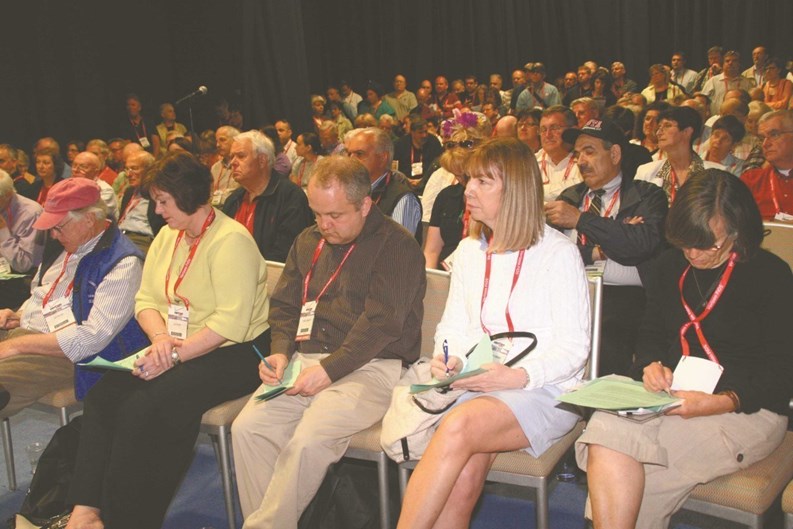Congratulations. You have been chosen to help lead your community on a small governing body that will determine the major policy decisions affecting everyone who lives in your community. From finances to rules enforcement to selection of personnel and services, your voice will be a major factor in the way things are done. Although an unpaid office, being on the board of a community association can be a position of esteem, responsibility and leadership. Are you ready for this?
Step One: Do Your Homework
If you are feeling a bit unprepared for what lies ahead, you have just stepped into a pool that includes a vast majority of people who have never served on a community association board. It’s likely that Co-op/Condo Board Fundamentals was left out of the curriculum at most high schools.
Although the three “R’s” do not include “Rules,” as in community association governing documents, there are ways to get up to speed on your new responsibilities—including what they are and what they aren’t.
The first step is to return to the governing documents themselves. You should have received them upon buying into the community, and even if you gave them the once-over back then, it is imperative that you read them again.
Exactly, just what do board members need to know? They need to have a firm grasp of the basics, says Lori E. Burger, CPM, PCAM, CCAM, CAM, who is the senior vice president of California-based Eugene Burger Management Corp.
Here is a good primer of their duties: an understanding of the governing documents which govern the association; a general understanding of the laws which impact the governance of the association; an understanding of parliamentary procedures including how to conduct and plan a board meeting; conflict resolution; how to prepare minutes and their importance; the roles of association officers; the ability to read financial statements and reserve studies; the ability to read a budget and understand what variance from the budget really means; the ability to instill a sense of community and being able to keep personal agendas aside from corporate decisions; an understanding how to make the best use of committees; an understanding the relationship between the management firm and the board and how to foster a good working relationship; learning the rights and responsibilities of the unit owner and that of the board; and skills relating to collections, landscaping, roofing, taxes, and accounting, asphalt and concrete, contracting, painting, pest control, or whatever.
“All of these skills at one time or another come into play,” states Burger. “I am just waiting for bedbug problems to hit HOAs...fun, fun,” she says with a laugh.
Both the Community Associations Institute (CAI) and Institute of Real Estate Management (IREM) offer many training options from coursework to webinars. One avenue to try is an online CAI series called “Board Member Basics,” a program to provide training for members of common-interest communities. The information in this program is ideal for current association board and committee members, those who aspire to community leadership positions and residents who want to understand how associations can and should function.
By studying the elements of this program, you will get the information, guidance and perspective you need to help create and maintain the kind of community people want to call home. Once you’ve gone through the basics, your local chapter is a good place to start on gaining some fundamental knowledge.
The “Essentials of Community Association Volunteer Leadership” program, formally called “The ABCs” is an excellent refresher course for professionals and experienced volunteers and provides students with comprehensive information about association communications, community-building policies, and association problem-solving skills, according to CAI. For more information on how to register for an upcoming Essentials course, contact your local CAI chapter. The New England chapter of CAI (CAI-NE) represents membership in Massachusetts, Rhode Island, Vermont and Maine. Claudette Carini is its executive director, and Beth Tramontozzi is the 2011 president. New Hampshire has a separate CAI chapter managed by executive director Cassandra Vorisek-Creto and presided over by Jeffrey Robinson, CMCA, for 2011.
Connecticut has formed its own chapter (CAI-CT) as well, headed by executive director Kim McClain. The 2011 president is N. Lynne McCarron, AMS.
McClain said CAI stresses “best practices” in its training curriculum. “Key skills involve communication and leadership development. Healthy associations typically have board members who are well-informed, e.g. attend education programs and keep the channels of communication as open as possible. They also seek to develop a network of volunteers and future board members,” she says.
Step Two: In-House Training
The next step is to contact the property’s management company to find out if they have any training materials or protocols for interacting with the board as a whole. This will also open a line of communication and may serve as an introduction to the organization that will be carrying out the day-to-day operations of the board’s decisions.
One of the reasons that you may find a lack of resources on how to be trained for board service is that each particular community has its own particular way of governing itself. The only way to know the details for sure is to consult the paperwork, and as a new authority and administrator, it will behoove you to have solid, first-hand knowledge of what they say.
“Each set of governing documents is different,” says Curt Macysyn, who is the executive vice president of the Community Associations Institute (CAI) chapter in New Jersey, “so there might be additional responsibilities. Each board operates in a manner that is tailored to its community. For example, some boards may have a liaison to the local government, while others may not.”
Many property management companies in New England offer training as a value-added service for the communities that they represent. One New York City-based accountant and management consultant even suggests implementing a training or procedures manual. “If your board doesn't have a procedures manual, it would be a worthwhile investment to create one,” says Mindy Eisenberg Stark, CPA, CFE. “Board member training should also be considered as a way to reduce time spent at board meetings and avoid reinventing the wheel every time there is a changeover on the board. Many boards discuss the same issues year in and year out with no resolution, or new members of the board revisit old issues time and again.”
Stark says that most board members are professionals in their own fields, but many don’t know the first thing about running a large residential building or development. This is where a manager can come in to orient new trustees, refresh veteran board members and even offer training to help the board as a whole become more cohesive and knowledgeable. By training trustees and keeping track of a building community’s institutional memory, managers enable boards to move forward without perpetually rehashing the same handful of issues.
Step Three: Be Responsible
The next step is to attend board meetings, and begin interacting with other board members in a way that will allow you to glean insights into board operations.
“The benefits are endless,” says Burger. “When a board understands thegoverning documents, financial and state law, governance and conflict resolution and how to interact with their management company, there is a better working relationship and far greater performance of the management company, there is owner satisfaction as well as vendor productivity. Additionally, serving on the board gives greater pleasure and less frustration and confusion.”
Newer board members also have the ability to see things differently, experts say. Fresh eyes are also better able to see gaps in communication and perhaps offer new solutions to old problems.
Educational Opportunities
Fortunately, there are several options available for people who wish to further their knowledge of community association government, and continuing education will strengthen any board. Burger says that groups such as IREM and CAI will help.
“It's just a plain fact,” says Burger. “If you are going to serve on a board you need to further your education. There are great resources online, whether through the state or other organizations. Sites like: IREM.org, HOAmanagement.com, caionline.org, caine.org, or caict.org, are useful, as well as offering courses or information from each individual state. IREM’s Boston chapter represents Massachusetts, Connecticut, Rhode Island, Vermont and Maine. However, they have also formed separate IREM chapters in the region (IREM Connecticut Chapter 51 and IREM Greater Rhode Island Chapter 88.) Non-management professionals—including HOA board members—can join IREM as “associate members,” which gives them access to the same curriculum offered to managers looking to gain professional credentials.
CAI also offers a variety of courses that address many areas of interest and levels of experience. These include: Level 1: Primer, an introduction to community associations; Level 2: Fundamentals, which covers basic operations and practical needs; Level 3: Essentials, which is designed to strengthen leadership skills and general knowledge; and Level 4: Selected Topics in Community Association Leadership, which provides in-depth study for people who wish to master certain community association skills, including building a community, conflict resolution and deed restrictions.
McClain noted that CAI-CT offers its “ABCs: A Basic Course for Association Operations” several times throughout the year and in different locations throughout the state. This program provides the opportunity to learn from experienced professionals and network with peers from a variety of associations, she says. “These types of interactions help to reduce the reinventing of wheels for many associations,” McClain adds.
“We also provide other training programs including multiple sessions at our annual conference, members only workshops and key issues seminars. Our national organization provides a plethora of options for webinars and an excellent free online course entitled "Board Member Basics." Also, a multitude of printed materials are available through national CAI in the form of guidebooks, pamphlets, news articles for reprint in association newsletters and more. Details about all these resources can be found on the CAI website: www.caict.org and on the national CAI website: www.caionline.org. There are many resources available for conscientious boards members.”
And don’t forget about trade shows. Most professional organizations have them complete with exhibitors, informative seminars, and opportunities to network with the trade professionals and board decision-makers in the condominium community. The New England Condominium sponsored its third New England Condo Expo in May at Boston’s Seaport World Trade Center, and is looking forward to its next information-packed event on May 22, 2012. IREM’s Fall Leadership Conference is set for October 11-15, 2011 in San Diego, California.
Some states like Florida and Nevada require board member training and the association would pay for board member attendance, Burger says. Some management companies also provide training at no cost.
Online Resources
Remember to go online for more resources as well. The CAI and IREM websites are a good place to start. The CAI bookstore contains a complete library of titles that pertain to living in an association. One topic of frequent debate is the enforcement of rules. People move to communities for a variety of reasons, and often what attracts them is the list of laws governing conduct. Noise complaints are a common issue in some communities, and when tempers flare, the board becomes a sounding board, as residents vent their frustrations to the governing authority. CAI has many guidebooks, including Be Reasonable, which covers various aspects of rules enforcement.
Board members must also keep up to speed on new developments, says McClain, and CAI is there to help. “Association governance is a very dynamic process. Laws are being changed, in particular new amendments to the Common Interest Ownership Act passed by the Connecticut General Assembly on June 8, 2011. New products and technologies are continually changing. It is imperative that those associations aspiring towards best practices ensure that they stay informed. A high level of commitment to best practices should ultimately lead to fewer problems with the management and governance of a thriving community.”
Advice from the Professionals
Keeping things in perspective is one of the best ways to make sure that the responsibility of being on a board does not become overwhelming. As for the best way to train to serve on a board, “There is no one-size-fits-all approach,” says Macysyn. “Everybody runs for the board for a different reason, but there are areas where at least understanding and following other people’s experiences will help along the way. The best teacher is experience, so the longer that you sit on the board and the more materials that you read, the better you will be at serving the community.”
Denton Tarver is a New York City-based freelance writer. Editorial Assistant David Chiu contributed to this article.







Leave a Comment